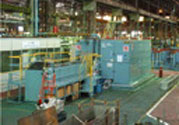Home > About Us > Corporate Social Responsibility > Sustainability Report > Environmental Sustainability Report 2004
| Environmental Management Environmental Sustainability Report 2004 |
|||
| Environment-friendly Production (3) |
 Chemical substances which are necessary in our lives can damage the ozone layer, human health and the ecosystem unless appropriate control is carried out. Kobe Steel shall continue to properly maintain its environmental facilities; thoroughly control chemical use or reduce the use of chemical substances; and switch to safer alternative substances.
Kobe Steel properly stores transformers, capacitors, and other components which contain PCB (polychlorinated biphenyl) in special-purpose storage and reports in compliance with the "Law concerning Special Measures against PCB Wastes."
In order to protect life from harmful ultraviolet light, it is imperative to reduce the use of ozone-depleting substances. To comply with the Montreal Protocol on Substances that Deplete the Ozone Layer, Kobe Steel stopped using cleaners containing designated CFCs at the end of fiscal 1994.
For waste incinerators, not only the amount of incinerated wastes is reduced by promoting collection of source separated refuse and recycling but also thoroughgoing operation control is implemented, such as preliminary screening of waste, equipment management, and combustion control. In addition, Kobe Steel controls the operation of sintering furnaces in compliance with the self-imposed guidelines of the iron and steel industry and implements meticulous equipment control and operation control for wastewater from aluminum alloy facilities, steelmaking electric furnaces, and wet waste gas scrubbers. With respect to dioxins generated unintentionally in these manufacturing processes, they are well below the compliance level. Kobe Steel will continue to strive for suppression of releasing dioxins by improvement and maintenance control of the facilities as well as appropriate operation control. |
||||||||||||||||||||||||||||||||||||||||||||||||||||||||||||||||||||||||||||||||||||||||||||||||||||||||||||||||||||||||||||||||||||||||||||||||||||||||||||||||||||||||||||||||||||||||||||||



